My mind’s been on Bobby Grich a lot lately. No, that’s not the start of a country song, but maybe it should be. Maybe it will be.
For now, though, what has me thinking about Grich is his proximity to a couple of players on this year’s Hall of Fame ballot and, earlier this week, his 76th birthday.
What’s pretty crazy to old-man me is that Chase Utley garnered 28.8% of the votes on his first Hall of Fame ballot in 2024 and is trending much higher so far in 2025, while Grich lasted just one round in 1992.
With that background as my inspiration — and with the results of this year’s election about to hit the wire — here are five baseball cards of some of the best players of the last several decades who fell off the Hall of Fame ballot after just one try.
1987 Donruss Bobby Grich (#456)
Grich spent 17 years in the majors, the first seven with the Orioles and the last ten with the Angels. Generally speaking, he was more of a star with the O’s, winning all four of his Gold Gloves with Baltimore. But he was an All-Star three times for each tema, and he ramped up his power later in his career, socking 30 home runs as the Angels won their first division title in 1979.
Grich also tied for the American League home run lead with 22 in the strike-torn 1981 season — along with Dwight Evans, Tony Armas, and Eddie Murray.
Overall, Grich hit .266 with 224 home runs, 864 RBI, 104 stolen bases, and 1833 hits. To be fair, Utley topped Grich in all those categories, but he also played in a much more offensive (hardy har) era. Grich holds the advantage in nerdier stats like WAR (71.1 to 64.5) and OPS+ (125 to 117).
And, if you use an all-in-one stat like JAWS to rank all second basemen, Grich comes in as eighth best ever, while Utley lands at number 12.
If you want a more old-school look at Grich’s case, all three major companies graced us with career-capper cards in 1987 after he finished his career following the 1986 ALCS. The 1987 Donruss card (above) only gives us the last five years of stats, but it does show us his career totals.
Plus, it gives us one last shot of Grich going to work in jos batting cage office.
1990 Upper Deck Darrell Evans (#143)
For awhile there in the late 1980s, it looked like Darrell Evans had found the baseball fountain of youth. Like he might play forever, or at least deep into his 40s. And he did, sort of.
After a decline-ish first season in Detroit for the 1984 juggernauts — .232, 16 home runs, 63 RBI — Evans found his groove in 1985. That summer, at the age of 38, he led the majors with 40 long balls, drove in 94 runs, and even received some down-ballot MVP consideration after the season.
Over the next three campaigns, he’d hit 29, 34, and 22 homers before signing a free agent deal with the Braves ahead of the 1989 season. It was a homecoming for Evans, who broke in with Atlanta back in 1969 and racked up his first (of two) 40-homer seasons as a Brave in 1973. Amazingly, Hank Aaron and Davey Johnson also went yard at least 40 times each for that club.
Alas, Evans’ Atlanta encore wasn’t quite as productive: .207, 11 HR, 39 RBI in 107 games. He took his last at-bat on October 1, and, though the Braves signed him again in January 1990, they released him at the end of Spring Training.
Five years later, Evans received eight votes on his one and only Hall of Fame ballot.
In between, we got a few career-cappers, including this 1990 Upper Deck number showing Howdy Doody in action at his transplanted position (first base) during his final season.
1991 Topps Rick Reuschel (#422)
Could it be that the baseball fountain of youth Evans drank from ran through the bowels of Candlestick Park? The curious case of Rick Reuschel suggests the two oldsters had more than their Giants uniforms in common.
See…
Almost four years after Evans left the Bay for the Motor City, Reuschel landed in San Francisco when the Pirates traded him westward late in the 1987 season. He was coming off a successful three-year run in Pittsburgh that included the 1985 Comeback Player of the Year award after a rotator cuff injury with the Cubs in 1982 looked like it might end his career.
Still, Reuschel was 38 at the time of the trade, and expectations weren’t super high. After a so-so performance down the stretch and an ugly two-game showing against the Cardinals in the NLCS, the big right-hander looked like he was winding down.
Not so much.
In 1988, Reuschel went 19-11 with a 3.12 ERA, and he followed up with a 17-8, 2.94 showing that belied his age (40) in 1989. That latter performance also helped the Giants win the National League West and also garnered Reuschel his third and final All-Star nod.
The results that fall weren’t so pretty for Reuschel as the Giants won the National League pennant before bowing to the A’s in the World Series. The downward trend continued in 1990, and Reuschel pitched his last game in April of 1991.
By that time, his final baseball cards, including the classy looking 1991 Topps card above, were finding their way into collector’s hands. Nearly six years later, Reuschel picked up two votes on his lone Hall of Fame ballot, well below the 24 he needed to see another.
1991 Stadium Club Chet Lemon (23)
If this list is starting to look like a rundown of the most underrated players of the 1970s and 1980s, well, that’s probably not much of a coincidence. After all, those were my formative years, and these guys were really good. Like, better-than-some-Hall-of-Famers good.
Chet Lemon certainly fits that bill.
After the A’s picked him in the first round of the 1972 draft, Lemon worked his way through the minors until Oakland traded him to the White Sox in June of 1975. He made his big league debut that September and never looked back.
Six years later, Lemon stood among the best young stars in the game when Chicago traded him to the Tigers. He was one of the final pieces of Detroit’s youth movement, and he slid right in as their All-Star caliber centerfielder. Two years later, he was one of the best players on one of the great teams of the last fifty years or so — maybe longer.
Lemon’s “problem” when it came/comes to recognition is that he was just consistently good-to-great while seldom being spectacular. He topped 15 homers in a season eight times, for example, but his top three totals were 24, 20, and 20.
Similarly, Lemon was excellent in the field, but he never won a Gold Glove.
The Tigers moved Lemon to right field in 1988 when Gary Pettis took over in center, but The Jet (Lemon) continued to play well: .264, 17 HR, 64 RBI. His power and batting average slipped in 1989 (7 HR, .237) in more limited playing time (127 games).
The 1990 season was a tough one for Lemon, as he was diagnosed with polycythemia vera in the spring, suffered multiple injuries, and dealt with off-field issues in his personal life. He made it into just 104 games and hit only five home runs, but he did draw 48 walks, boosting his on-base percentage to .359.
Lemon gave it another go at Spring Training in 1991, but the Tigers waived him shortly before the season started. That same spring, though, collectors got one last round of Lemon cards, including the entry you see above from the “premium” Stadium Club set.
Five years later, he received a single vote on his only Hall of Fame ballot.
1993 Topps Dave Stieb (#295)
“Jack Morris won more games than any other pitcher during the 1980s.”
“Jack Morris pitched 1000 innings in Game 7!”
“Jack Morris threw a no-hitter!!”
“Jack Morris knew how to win!!!”
OK, I’ll stop now. And I’ll even concede that Jack Morris was an excellent pitcher. A real gamer. Maybe even a great pitcher.
But for every point up there, it’s not that hard to come up with a counterpoint. I’m not going to do that here, though, because his slot is reserved for Dave Stieb, who was as good or better than Morris over roughly the same career span.
Stieb is (moderately) famous as the ace of some good-to-great 1980s Blue Jays teams, and infamous for his five one-hitters. He finally did get his no-hitter in 1990, though, and he also finally got a ring with the 1992 Blue Jays…even though he was injured and didn’t play that October.
Stieb finished his career with the White Sox in 1993…and then came back five years later and finished his career — again — by appearing in 19 games for the 1998 Blue Jays, at age 40.
In 2004, he appeared on the Hall of Fame ballot for the first (and only) time and got seven votes. By way of comparison, Morris was on the ticket for the fifth time that winter and picked up 133 nodes
Stieb did make at least one cardboard appearance with the White Sox, in the 1993 Upper Deck Hi Series, but he doesn’t have a true career-capper. So what say we remember him in his happy Toronto days, on a bright and clean 1993 Topps card?
Bonus - 1977 Topps Willie Davis (#603)
This one’s a bonus because 1) Davis may be the best player on this list, 2) his 1977 Topps card shows him with the wrong team but looks great anyway, and 3) he doesn’t really fit our criteria.
See, after starring for the Dodgers through the 1960s and into the early 1970s, Davis embarked on a road trip that took him to Montreal, Arlington, St. Louis, Friartown, Japan, Anaheim, and Mexico.
The stop with the Angels in 1979 would encompass his last major league games, but even though he’s something like the 16th greatest centerfielder ever by measure of JAWS, Davis never made it to the Hall of Fame ballot.
Boo hiss. 3-Dog deserved/deserves better.
—
So, who’s your favorite one-and-done, or none-and-done, Hall of Fame candidate? I’d love to hear your picks.
Thanks for reading.
—Adam




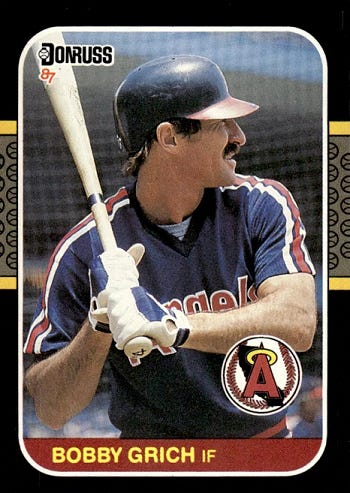
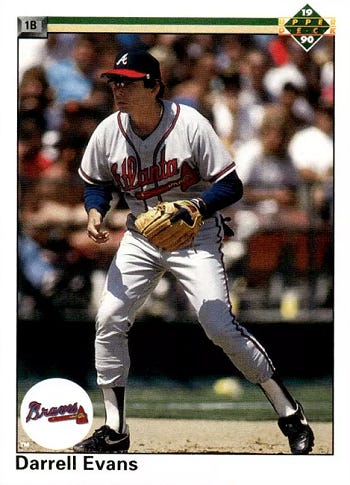

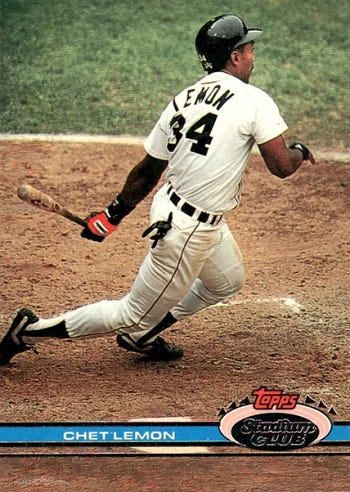
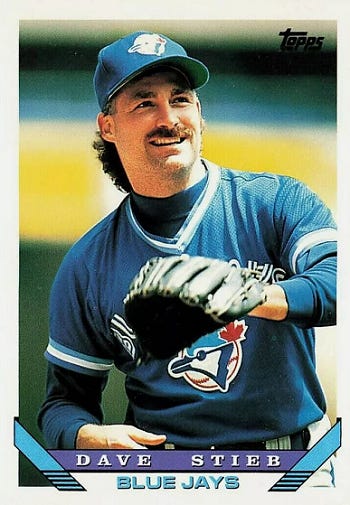
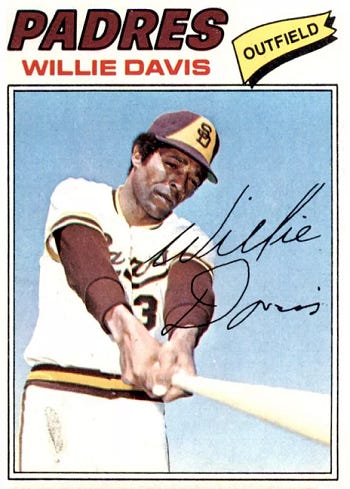
Good read, but how did you miss Sweet Lou? Another member of that great 1984 team.
Any chance that you’re a reader of Joe Posnanski’s blog? He shares your opinion about all of these vastly underrated players.